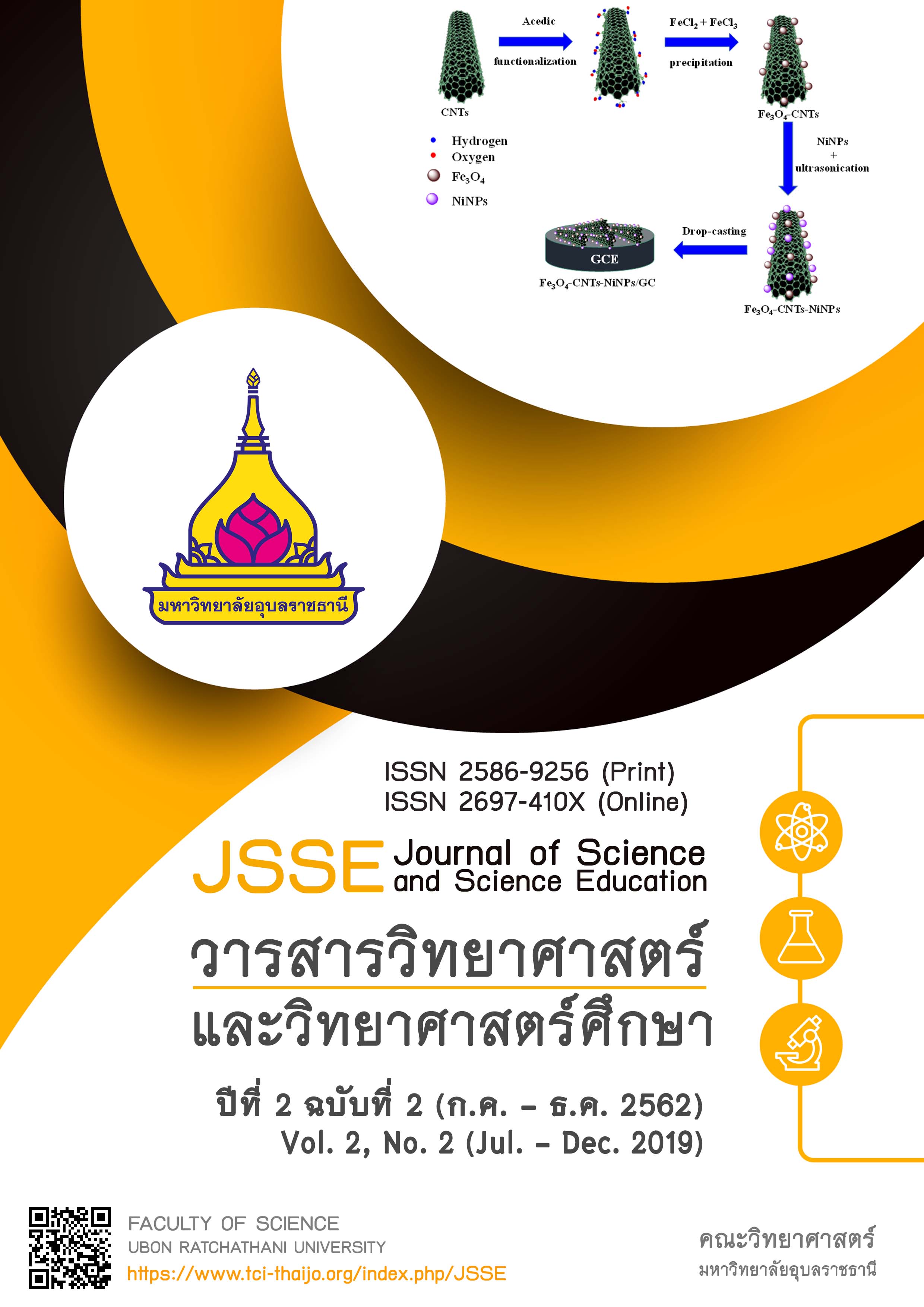การพัฒนาทักษะการแก้โจทย์ปัญหา เรื่องอัตราส่วนและร้อยละ ของนักเรียนชั้นมัธยมศึกษาปีที่ 2 โดยการจัดการเรียนรู้แบบร่วมมือด้วยเทคนิค STAD ร่วมกับเทคนิค KWDL
Main Article Content
บทคัดย่อ
การแก้โจทย์ปัญหาทางคณิตศาสตร์เป็นทักษะพื้นฐานสำหรับนักเรียนในทุกระดับชั้น วิธีการหนึ่งที่รู้จักกันแพร่หลายที่ช่วยฝึกนักเรียนแก้โจทย์ปัญหา โดยเน้นขั้นตอนการคิดของนักเรียน คือ การฝึกให้นักเรียนมีทักษะการแก้ปัญหาตามเทคนิค KWDL ดังนั้น การวิจัยครั้งนี้มีวัตถุประสงค์เพื่อ 1. ศึกษาทักษะการแก้โจทย์ปัญหา เรื่องอัตราส่วนและร้อยละ ของนักเรียนชั้นมัธยมศึกษาปีที่ 2 โดยการจัดการเรียนรู้แบบร่วมมือด้วยเทคนิค STAD ร่วมกับเทคนิค KWDL 2. เปรียบเทียบทักษะการแก้โจทย์ปัญหา เรื่องอัตราส่วนและร้อยละ ของนักเรียนชั้นมัธยมศึกษาปีที่ 2 ก่อนและหลังการจัดการเรียนรู้แบบร่วมมือด้วยเทคนิค STAD ร่วมกับเทคนิค KWDL กลุ่มตัวอย่างในการวิจัยครั้งนี้ เป็นนักเรียนชั้นมัธยมศึกษาปีที่ 2 โรงเรียนกมลาไสย อำเภอกมลาไสย จังหวัดกาฬสินธุ์ ภาคเรียนที่ 1 ปีการศึกษา 2561 จำนวน 39 คน เครื่องมือที่ใช้ในการวิจัยได้แก่ แผนการจัดการเรียนรู้แบบร่วมมือด้วยเทคนิค STAD ร่วมกับเทคนิค KWDL และแบบทดสอบวัดทักษะการแก้โจทย์ปัญหา สถิติที่ใช้ในการวิเคราะห์ข้อมูล คือ ค่าร้อยละ ค่าเฉลี่ย ส่วนเบี่ยงเบนมาตรฐาน และ t-test ผลการวิจัยพบว่า 1. ผลลัพธ์ของทักษะการแก้โจทย์ปัญหาของนักเรียนคิดเป็นร้อยละ 69.85 ( =13.97, S.D.=1.06) 2. ทักษะการแก้โจทย์ปัญหา เรื่องอัตราส่วนและร้อยละ ของนักเรียนโดยการจัดการเรียนรู้แบบร่วมมือด้วยเทคนิค STAD ร่วมกับเทคนิค KWDL หลังเรียนสูงกว่าก่อนเรียน อย่างมีนัยสำคัญทางสถิติที่ระดับ 0.01
Article Details
วารสารวิทยาศาสตร์และวิทยาศาสตร์ศึกษา (JSSE) เป็นผู้ถือลิสิทธิ์บทความทุกบทความที่เผยแพร่ใน JSSE นี้ ทั้งนี้ ผู้เขียนจะต้องส่งแบบโอนลิขสิทธิ์บทความฉบับที่มีรายมือชื่อของผู้เขียนหลักหรือผู้ที่ได้รับมอบอำนาจแทนผู้เขียนทุกนให้กับ JSSE ก่อนที่บทความจะมีการเผยแพร่ผ่านเว็บไซต์ของวารสาร
แบบโอนลิขสิทธิ์บทความ (Copyright Transfer Form)
ทางวารสาร JSSE ได้กำหนดให้มีการกรอกแบบโอนลิขสิทธิ์บทความให้ครบถ้วนและส่งมายังกองบรรณาธิการในข้อมูลเสริม (supplementary data) พร้อมกับนิพนธ์ต้นฉบับ (manuscript) ที่ส่งมาขอรับการตีพิมพ์ ทั้งนี้ ผู้เขียนหลัก (corresponding authors) หรือผู้รับมอบอำนาจ (ในฐานะตัวแทนของผู้เขียนทุกคน) สามารถดำเนินการโอนลิขสิทธิ์บทความแทนผู้เขียนทั้งหมดได้ ซึ่งสามารถอัพโหลดไฟล์บทความต้นฉบับ (Manuscript) และไฟล์แบบโอนลิขสิทธิ์บทความ (Copyright Transfer Form) ในเมนู “Upload Submission” ดังนี้
1. อัพโหลดไฟล์บทความต้นฉบับ (Manuscript) ในเมนูย่อย Article Component > Article Text
2. อัพโหลดไฟล์แบบโอนลิขสิทธิ์บทความ (Copyright Transfer Form) ในเมนูย่อย Article Component > Other
ดาวน์โหลด ไฟล์แบบโอนลิขสิทธิ์บทความ (Copyright Transfer Form)
เอกสารอ้างอิง
Eisenmann, P. Novotná, J. Přibyl, J. and Břehovský, J. (2015). The development of a culture of problem solving with secondary students through heuristic strategies. Mathematics Education Research Journal, 27, 535-562.
Ministry of Education, Thailand. (2010). Basic education core curriculum B.E. 2551 (A.D. 2008) (in Thai). Bangkok: The Agricultural Co-operative Federation of Thailand Ltd.
Mudwan, C. (2009). A study of mathematics problem-solving abilities and group process abilities of primary grae-5 students taught by STAD teaching technique together with KWDL teaching technique (in Thai). Master’s Thesis of Education in Curriculum and Instruction. Songkhla: Thaksin University.
Ogle, D. M. (1986). K-W-L: A teaching model that develops active reading of expository text. Reading Teacher, 39(6), 564-570.
Pengjan, C., Tanachaikhan, N. and Panyapreuk, S. (2017). The learning management by using KWLD technique to develop learning achievement in mathematics entitle “sentence problems” of Prathomsuksa 6 students (in Thai). Journal of Graduate Research, 8(1), 71-82.
Salae, S, Pakapongpun, A. and Dokchan, R. (2018). The effect of using learning management KWDL technique on measures of central value for Mathayomsuksa 5 student’s mathematics learning achievement and communication abilities (in Thai). Journal of Education Naresuan University, 20(4), 35-44.
Sangsawang, P. and Laisema, S. (2017). The development of simulation multimedia online lesson together with kwdl technique towards mathematical problems solving ability of Prathomsuksa 3 students Watraikhing (Sunthornutis) School (in Thai). Veridian E-Journal, Silpakorn University: Humanities, Social Science and Arts (Thai edition), 10(2), 2250-2266.
Shinno, B. and Sriprom, M. (2014). Development of The STAD cooperative learning in conjunction with the mathematical modelling affecting mathematical problem solving abilities, teamwork behaviors, and attitudes toward mathematics of Mathayom Suksa 4 students (in Thai). Graduate Studies Journal, 11(52), 75-88.
Someprayoon, W. (1998). Research and development of instructional model and instruction media in mathematics (in Thai). Bangkok: Faculty of Education, Srinakharinwirot University.
Srisuantang, A. (2013). The development of learning outcomes on mix-problems of fourth grade students taught by brain-based learning (BBL) together with KWDL technique. Veridian E-Journal, Silpakorn University: Humanities & Social Science and Science (Thai edition), 6(2), 223-236.


